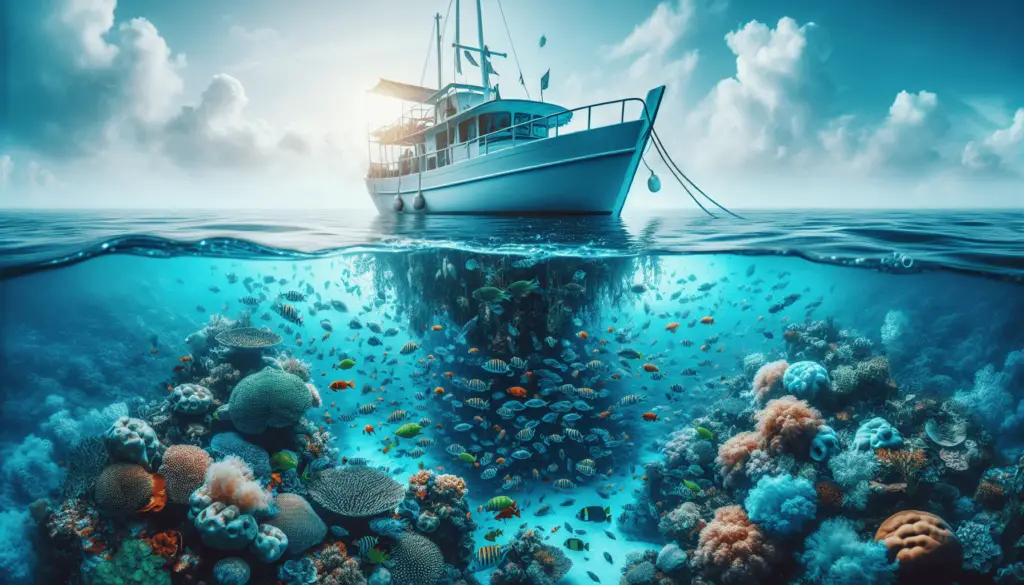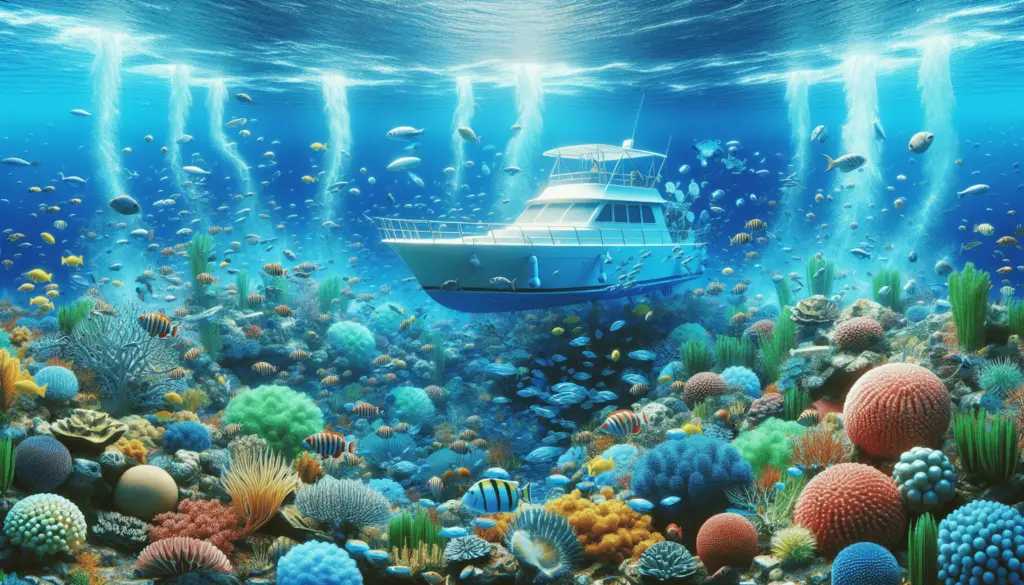Imagine peacefully anchoring your boat, the waves gently lapping against the hull, while still being a responsible steward of the ocean environment. That’s what “Eco-Friendly Practices for Anchoring and Mooring Your Boat” is all about. This meaningful and informative read is going to empower you with the knowledge and strategies required to anchor or moor your boat in an eco-friendly manner. You’ll learn about best practices and techniques that won’t just instill peace in you, but also protect and preserve the pristine marine life that surrounds you every time you set sail.
Understanding Marine Eco-Systems
Marine ecosystems are remarkable, mysterious, and incredibly diverse. They teem with millions of species, including the largest creatures who’ve ever lived on this planet. They play a crucial role in the global climate system and produce half the world’s oxygen. Keeping these ecosystems healthy requires everyone’s participation – and that includes you, the boaters.
Identifying sensitive marine habitats
Every boater should understand where sensitive marine habitats are within their regular boating areas. These areas, such as seagrasses, coral reefs, and mangrove forests, are crucial for marine life. If disturbed, they can take years or decades to recover. Therefore, it’s essential for you to understand how to identify these sensitive areas and navigate around them to avoid causing harm.
Impacts of boat anchoring on marine eco-systems
You may not realize it, but every time your anchor touches the seafloor, it can have devastating effects on marine ecosystems. Anchors can cause physical damage, smothering, or even completely destroy habitats such as seagrass beds and coral reefs. The impact can also decrease the overall diversity of marine life in that area. Over the long run, these effects can dramatically alter marine ecosystems.
Role of boaters in marine eco-system conservation
As a boater, you play an integral role in marine ecosystem conservation. Practicing responsible boating, which includes choosing the right anchor, using proper anchoring and mooring techniques, and participating in conservation efforts, can make a significant difference. By taking these actions, you can protect marine ecosystems and ensure they continue to thrive for future generations.
Choosing Eco-Friendly Anchor Types
Boat anchors come in various shapes, sizes, and materials. Still, not all of them are equal when it comes to their impact on the environment. It’s important to select anchors that are eco-friendly to minimize any harm they might cause.
Criteria for selecting eco-friendly anchors
An eco-friendly anchor should cause minimal disruption to the sensitive marine habitats. It should weigh enough to hold the boat in position, but not so much that it causes damage when dragged along the seafloor. The anchor’s design should also promote easy retrieval, thus avoiding dragging.
Review and comparison of different anchor types
From the traditional mushroom anchors to more modern designed plow anchors, each type of anchor has its benefits and drawbacks. Some, like the mushroom anchor, penetrate the seafloor, causing disruption in its wake. However, plow anchors, while more expensive, cause less damage as they don’t necessarily need to penetrate the seafloor to secure the boat.
Proper usage of anchors for minimum impact
Using environmentally friendly anchors involves more than just picking the right type. It’s also about how you use them. Proper technique – like gently lowering the anchor instead of throwing it, ensuring the anchor chain isn’t dragging on the sea bottom, using the right amount of rode – can all minimize the impact your anchor has on the seascape.

Eco-Friendly Mooring Systems
Another excellent way to further reduce your impact on marine ecosystems is to use eco-friendly mooring systems.
Introduction to eco-friendly mooring systems
Eco-friendly mooring systems, sometimes called conservation moorings, are designed to minimize damage to the seafloor. Unlike traditional mooring systems made with heavy blocks or screws that can scrape and scar the seafloor, eco-friendly moorings utilize elastic rodes and small anchors that have less impact.
Benefits of using eco-friendly mooring systems
Using eco-friendly mooring systems provides a host of benefits. Not only do they reduce damage to marine habitats, but they also reduce wear-and-tear on your equipment, increase safety due to their superior hold, and improve the boating experience by providing a smoother ride.
Popular eco-friendly mooring systems in the market
There are many eco-friendly mooring systems available today. Some popular ones include the Seaflex system, Manta Ray Anchors, and Helix mooring systems. While all of them minimize damage to the marine environment, your choice will depend on your specific needs and budget.
Proper Anchoring Techniques
Knowing how to anchor your boat correctly is a must for every boater.
Importance of proper anchoring
Proper anchoring can save a lot of headaches and potential problems. More than that, it can minimize the impact on the marine environment. A correctly placed and held anchor causes less damage to the seafloor and can be safely retrieved without causing additional harm.
Steps in proper anchoring
Proper anchoring involves several steps. These include selecting the right location, preparing the anchor, gently lowering the anchor to the seafloor, setting the anchor firmly by gradually applying pressure, and periodically checking to confirm the anchor is holding.
Common mistakes in anchoring and their eco-impacts
Even experienced boaters can make mistakes when anchoring. These mistakes can compound the harm to the marine environment. Common errors include setting the anchor in sensitive habitats, using excess chain that drags along the seafloor, and quickly pulling up the anchor which can damage seafloor habitats.

Proper Mooring Techniques
Like anchoring, correct mooring practices are essential for minimizing your impact on marine ecosystems.
Significance of proper mooring techniques
Proper mooring techniques involve securing your boat to a deigned anchoring system, reducing the impact on the seabed. It helps conserve sensitive marine areas by avoiding direct contact with the seafloor.
Commonly used eco-friendly mooring techniques
Eco-friendly mooring involves using systems designed with minimal ecological impact. This could mean using a buoy system attached to an eco-friendly anchor, utilizing set mooring posts, or even using floating docks. The technique used will depend on the specific circumstances and location.
Mistakes in mooring and their potential environmental effects
Unfortunately, mistakes in mooring can be as harmful as bad anchoring habits. Common mistakes include tying the boat to sensitive structures like coral or seagrass beds, tugging or yanking on mooring lines, and using inappropriate mooring systems for the particular location.
Avoiding Sensitive Marine Areas
Part of responsible boating means knowing how to identify and avoid sensitive marine areas.
Identifying sensitive marine areas
Sensitive marine areas are often clearly marked or designated. These can include protected marine parks, seagrass beds, coral reefs, shellfish beds, and other areas rich in biodiversity. As a responsible boater, it’s your duty to recognize these areas and take action not to disturb them.
Tips for boating in sensitive marine areas
Boating in sensitive marine areas requires particular care. Use charts and marine GPS systems to familiarize yourself with the area. Keep an eye out for buoy markers indicating sensitive zones. Most importantly, practice slow speeds, use eco-friendly anchors/mooring systems, and observe any rules or regulations in place.
Legal implications of damaging sensitive marine habitats
Barrier damages to sensitive marine habitats can hold severe legal repercussions. These can include fines, penalties, and even criminal charges in extreme cases.
Maintenance and Disposal of Anchors and Moorings
Proper maintenance and disposal of anchors and moorings are another crucial part of eco-friendly boating.
Importance of regular anchor and mooring maintenance
Regular maintenance ensures your anchors and moorings are in good condition and can perform their job effectively. It helps prevent unexpected failures that could potentially damage your boat or the marine environment.
Best practices in anchor and mooring disposal
When it comes to disposing of old anchors and moorings, don’t just dump them overboard. Many are made from materials that can have harmful effects on marine life and environments. Instead, recycle or dispose of them properly on land.
Recycling opportunities for old anchors and moorings
Many areas offer recycling programs for marine gear, including anchors and moorings. Check with your local waste management facility or marina for options. Alternatively, consider donating your old gear to organisations that can refurbish and reuse them.
Participation in Conservation Efforts
As a boater, you can play an active role in marine conservation efforts.
Boater roles in marine conservation efforts
From advocating for responsible boating practices to volunteering in clean-up events, there are plenty of opportunities for you to contribute to marine conservation efforts. Remember, every small action can make a difference.
Volunteering and donation opportunities for boaters
Numerous organizations and agencies welcome boaters’ involvement through volunteering or donations. You can participate in beach cleanups, contribute financially to marine conservation nonprofits, or participate in citizen science projects.
Reporting damages to authorities
If you notice any significant damage to marine habitats due to boating activities, don’t hesitate to report it to the relevant authorities. They can then take the necessary action to address the damage and prevent future incidents.
Educating Other Boaters
Sharing knowledge and experiences with other boaters is another way to protect our marine environment.
Importance of boater education in conservation
Educating other boaters about eco-friendly practices can have a multiplied effect. The more boaters are aware and put these practices into action, the greater the impact on protecting our marine ecosystems.
Sharing knowledge and experiences with other boaters
Share your experiences and learnings with others. Whether it’s through conversations at the marina, online boating forums, or formal education programs, every bit of knowledge shared helps.
Organising educational events for local boater communities
Consider organizing or participating in educational events in your local boating community. Workshops, seminars, or even casual get-togethers can serve as valuable platforms to disseminate information and promote responsible boating practices.
Legislation and Guidelines
Being aware of and complying with relevant laws and guidelines is a part of being a responsible boater.
Overview of relevant regulations and guidelines
Many laws and guidelines govern boating activities to protect marine ecosystems. These can vary from place to place, so make sure you’re familiar with those in your boating areas.
Keeping up-to-date with changing laws
Regulations and guidelines can change over time. Stay updated by regularly checking with your local maritime authority or boating organization.
Tips to ensure compliance with legislation
One of the best ways to ensure you’re always in compliance with any laws is to practice good habits from the start. Be aware, be responsible, and when in doubt, always choose the action that minimizes harm to the marine environment.
Eco-friendly practices in anchoring and mooring are integral parts of responsible boating. By following these guidelines, you can enjoy your time on the water and play your part in preserving our precious marine ecosystems. Let’s work together to keep our oceans healthy for generations to come. Happy boating!

